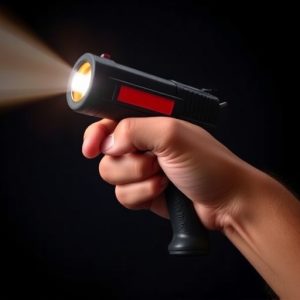Unveiling the Workings of Stun Guns: Electrical Mechanisms and Capacitation Safety
Stun guns are non-lethal self-defense tools that deliver a high-voltage, low-ampere electrical char…….
Stun guns are non-lethal self-defense tools that deliver a high-voltage, low-ampere electrical charge to temporarily incapacitate an attacker. They operate by causing rapid muscle contractions and spasms through the overstimulation of motor nerves, which disrupts neural signals and leads to intense pain, disorientation, and involuntary movements without causing permanent harm. Unlike traditional electric shocks, stun guns require less current to be effective, reducing the risk of severe injury. The effectiveness of a stun gun depends on its design and the user's knowledge of its operation; it must target large muscle groups, especially during training, as environmental factors can affect performance. It is crucial for users to understand how does a stun gun work, adhere to local laws, follow safety protocols, and recognize potential risks before employing one for personal defense. This knowledge ensures responsible use and understanding of the device's purpose within legal and ethical boundaries.
When confronted with the question of how does a stun gun work, the answer lies within its electrical mechanisms and their profound impact on the human body’s nervous system. This article delves into the intricacies of stun guns, exploring the science behind electro-muscular disruption and its effects. We will unravel the technical aspects that render an individual incapacitated, while also addressing safety and effectiveness considerations for those who may use a stun gun in self-defense. Join us as we demystify the workings of these devices and provide a clear understanding of their capabilities and limitations.
The Electrical Mechanisms Behind Stun Guns: Understanding the Impact on Nervous Systems
Stun guns are self-defense devices that incapacitate assailants through an electrified grid of electrodes connected to a power source. When activated, they deliver a high-voltage, low-ampere electrical charge that disrupts the muscle function of the target individual. The impact of a stun gun on the human body is primarily due to its electrical mechanisms, which exploit the conductive properties of the human physiology.
The electrical current emitted by a stun gun passes through the body’s tissues and interferes with the nervous system’s communication pathways, causing neuromuscular incapacitation. The charged prongs, or probes, deliver an electric shock that induces involuntary muscle contractions and disorientation. This occurs because the electrical impulses from the stun gun stimulate the motor nerves, triggering muscles to contract uncontrollably. The resulting neurological effects include intense pain, muscular paralysis, and temporary immobilization, effectively neutralizing an attacker’s ability to continue a physical threat. Understanding how a stun gun works involves grasping the complex interaction between its electrical output and the physiological responses it elicits in the human body. The design of stun guns is such that they deliver a non-lethal shock, specifically engineered to incapacitate rather than cause permanent harm. This understanding is crucial for legal and ethical considerations surrounding their use as a means of self-defense.
Electro-Muscular Disruption Explained: How Stun Guns Incapacitate
When considering the mechanics of incapacitation through electro-muscular disruption, it’s clear that stun guns function by delivering a high-voltage, low-current electrical charge. This charge interferes with the nervous system’s ability to signal muscles to contract, effectively disrupting voluntary muscle movements. The process initiates when the stun gun makes contact with an individual; the device emits a pulse that rapidly depolarizes nerve and muscle membranes. This rapid depolarization triggers continuous muscular contractions and involuntary muscle spasms. The resulting overstimulation of motor nerves by the electrical impulses overwhelms the body’s motor systems, causing a temporary but profound paralysis or immobilization.
The efficiency of stun guns in incapacitating individuals is rooted in their ability to produce an electric shock that specifically targets the electro-muscular system. Unlike conventional electric shocks that would require high amperage to be effective, stun guns use a sophisticated electrical pulse that can be safely delivered at a much lower amperage. This precise application of electricity minimizes the risk of causing permanent harm while ensuring the subject’s muscles are effectively immobilized. The disruption of normal muscle function by the stun gun’s electrical output occurs without significant injury, leading to a state of temporary incapacitation that allows for the control and restraint of an individual who might otherwise pose a threat or escape.
Safety and Effectiveness Considerations for Stun Gun Users
When considering the safety and effectiveness of stun guns for personal defense, it’s crucial to understand their mechanisms and operational aspects. A stun gun operates by delivering a high-voltage, low-amp electrical charge that quickly overwhelms the target’s nervous system, causing muscle spasms and temporary paralysis. This incapacitating effect is due to the electric current disrupting the neural signals between the brain and the muscles, effectively rendering an assailant immobile for a few minutes.
Users must be aware of several considerations to ensure their safety and the effectiveness of the device in self-defense situations. Firstly, the stun gun should be used with precision, aiming for large muscle groups like the torso or legs, rather than sensitive areas that may raise ethical concerns or cause unintended harm. Training is imperative; users must familiarize themselves with the proper handling and aiming of the device to deploy it effectively in a confrontation. Additionally, environmental factors such as weather conditions can affect the performance of a stun gun, so users should consider these when deciding to carry and use one. It’s also vital to understand that while stun guns are designed to be non-lethal, there is always a risk of over or under delivery of the shock, which could lead to unintended consequences. Therefore, potential users should thoroughly research laws and regulations governing the use of stun guns in their jurisdiction, adhere to safety guidelines, and consider the potential risks before relying on a stun gun as a defense mechanism. Understanding how does a stun gun work is foundational for making informed decisions about its safety and effectiveness.


